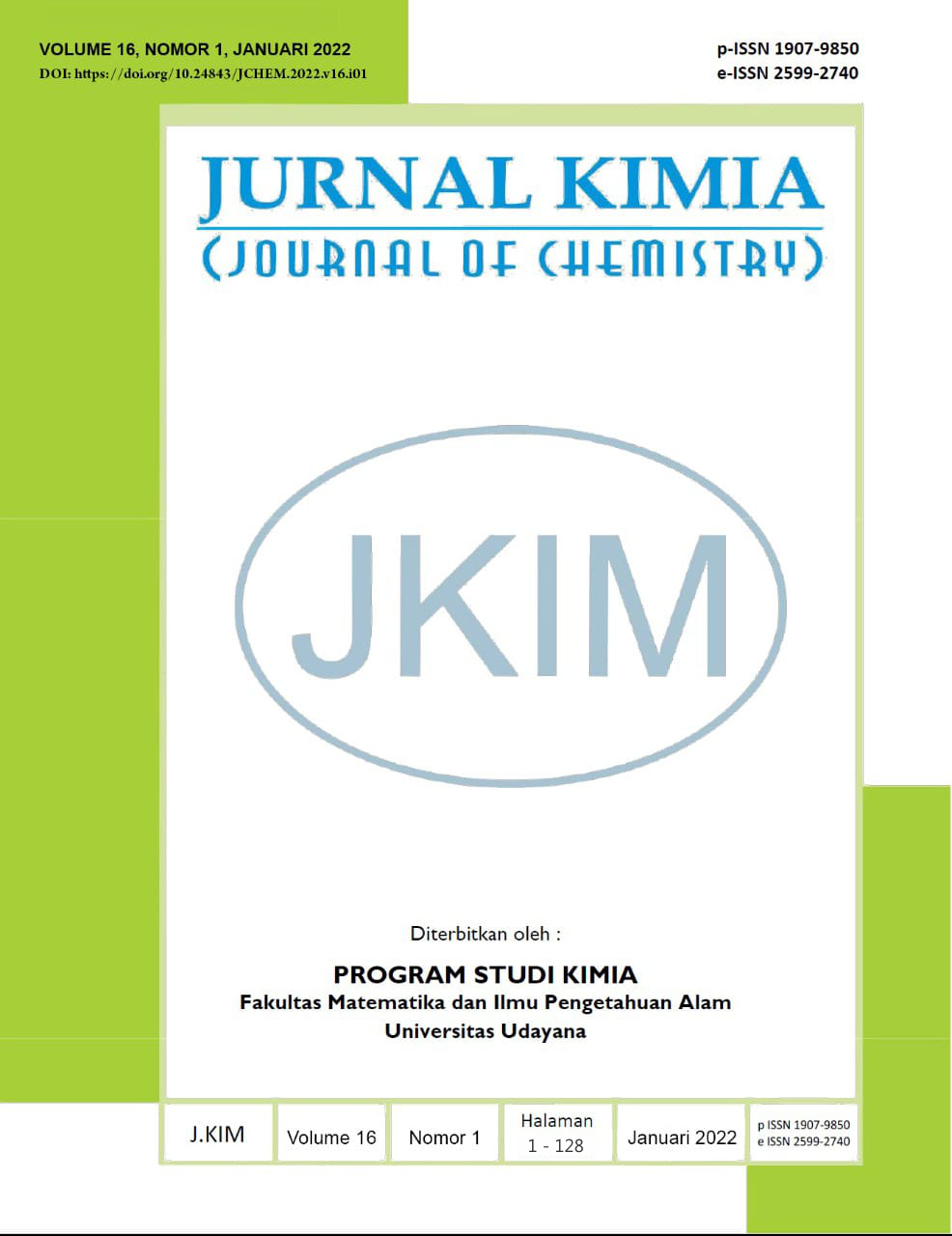SPESIASI DAN BIOAVAILABILITAS LOGAM BERAT Pb DAN Cu DALAM TANAH PERTANIAN DI DESA SUKAWANA, KINTAMANI
Abstract
Tanah pertanian yang sering diberi pupuk anorganik maupun organik cenderung tercemar oleh logam berat yang terkandung dalam pupuk tersebut. Logam berat dalam tanah, terutama yang bersifat bioavailable dapat terserap dan masuk ke bagian tanaman yang tumbuh di tanah tersebut. Penelitian ini bertujuan untuk menentukan kandungan logam Pb dan Cu total serta bioavailabilitas kedua logam tersebut dalam tanah pertanian untuk berbagai jenis sayuran di Desa Sukawana, Kintamani, Bali-Indonesia. Metode ekstraksi bertahap digunakan untuk melakukan spesiasi Cu dan Pb dan teknik Atomic Absorption Spectrometry digunakan untuk pengukuran absorbansi kedua logam. Hasil penelitian menunjukkan bahwa kandungan logam Pb dan Cu total dalam sampel tanah pertanian berturut-turut (40,3607-167,4051) mg/kg dan (26,7679-35,7764) mg/kg. Hasil spesiasi menunjukkan bahwa fraksi labil (F1) paling rendah untuk kedua logam, fraksi reducable (F2) lebih kecil dari fraksi oxidicable (F3) baik untuk logam Pb maupun Cu, sedangkan fraksi terbesar adalah fraksi inert (F4) untuk Pb dan fraksi oxidicable (F3) untuk Cu dengan kata lain: F4>F3>F2>F1 untuk Pb dan F3>F2>F4>F1 untuk Cu. Logam Pb dan Cu yang bioavailable (F1) jauh lebih kecil dibandingkan dengan jumlah logam yang berpotensi bioavailable (F2 dan F3). Persentase logam Pb dan Cu yang berpotensi bioavailable berturut-turut berkisar antara (47,57-53,38)% dan (88,29-95,70)%. Persentase logam Pb dan Cu yang rendah pada fraksi bioavailable mengindikasikan bahwa sayuran yang ditanam di area tanah pertanian tersebut aman dari cemaran kedua logam.
Kata kunci: bioavailabilitas, Cu, Pb, spesiasi
Agricultural soils which are frequently given inorganic or organic fertilizers tend to be polluted by heavy metals contained in the fertilizers. Heavy metals in the soil, especially those being bioavailable, can be absorbed and enter all the parts of the plant growing on the soil. This study aimed to determine the total contents of Pb and Cu as well as the bioavailability of the metals in agricultural soil used for vegetables cultivating in Sukawana Village, Kintamani, Bali-Indonesia. The sequential extraction method was used to perform the speciation of Cu and Pb and the Atomic Absorption Spectrometric technique was used to measure the two metals. The results showed that the total metal contents of Pb and Cu in agricultural soil samples were (40.3607-167.4051) mg/kg and (26.7679-35.7764) mg/kg, respectively. The speciation results showed that the labile fraction (F1) was the lowest for both metals, the reducable fraction (F2) was smaller than the oxidicable fraction (F3) for both Pb and Cu, while the largest fraction was the inert fraction (F4) for Pb and the oxidicable fraction (F3) for Cu, in other words: F4>F3>F2>F1 for Pb and F3>F2>F4>F1 for Cu. The bioavailable Pb and Cu (F1) were much smaller than the amount of metals being potentially bioavailable (F2 and F3). The percentages of potentially bioavailable Pb and Cu metals ranged from (47.57-53.38)% and (88.29-95.70)%, respectively. The low percentage of Pb and Cu in the bioavailable fraction indicated that vegetables planted in the agricultural land area were safe from contamination of both metals.
Keywords: bioavailability, Cu, Pb, speciation
Downloads
References
Angima, S. 2010. Toxic Heavy Metals in Farm Soil. Oregon State University. V(3): 1-3.
Filipović-Trajković, R., Ilić, Z. S., Sunić, L., and Andjelković, S. 2012. The Potential of Different Plant Species for Heavy Metals Accumulation and Distribution. Journal of Food, Agriculture & Environment. 10(1): 959-964.
Gasparatos, D., Haidouti, C., Adrinopoulos, F., and Areta. O. 2005. Chemical Speciation and Bioavailability of Cu, Zn and Pb on Soil from the National Garden of Athens, Greece. Proceedings of the 9 th International Conference on Enviromental Science and Technology. Rhodes Island, Greece 1-3 September. p. A-438 – A-444.
Jena, V., Gupta, S., Dhundhel, R. S., Matie, N., Bilinski, S. F., and Devie, N. 2013. Determination of Total Heavy Metal By Sequential Extraction from Soil. International Journal of Research in Environmental Science and Technology. 3(1): 35-38.
Jia, L., Wang, W., Li, Y., and Yang, L. 2010. Heavy Metals in Soil and Crops of an Intensively Farmed Area: A Case Study in Yucheng City, Shandong Province, China. Int. J. Environ. Res. Public Health. 7: 395-412.
Parmiko, I P. M., Siaka, I M., Suarya, P. 2014. Kandungan Logam Cu dan Zn Dalam Tanah Pertanian di daerah Bedugul. Jurnal Kimia (Journal of Chemistry). 8(1): 91-96
Regi, M., Siaka, I M., Suprihatin, I. E. 2018. Bioavailabilitas Logam Berat Pb dan Cd dalam Tanah Perkebunan Budidaya Kubis di Daerah Kintamani Bangli. Ecotrophic. 12(1) : 42-49.
Siaka, I M. 2016. Spesiasi dan Bioavailabilitas Logam Berat dalam Tanah dan Akumulasinya dalam Sayuran Sebagai Dasar Penentuan Tingkat Aman Konsumsi. Disertasi. Pasca Sarjana Universitas Udayana. Fakultas Pertanian. Denpasar, Bali
Siaka, I M., Udayani, P. D. S. and Suyasa, I W. B. 2021. Bioavailabilitas dan Kandungan Logam Pb, Cu pada Tanah dan Sawi Putih di Desa Baturiti. Jurnal Kimia (Journal of Chemistry). 15(1): 20-28
Siaka, I M., Utama, I M. S, Manuaba, I. B. P., and Adnyana, I M. and Sahara, E. 2016. Speciation and Bioavailability of Some Heavy Metals in Agricultural Solis Used for Cultivating Various Vegetables in Bedugul, Bali. The 5 th international Conference and Workshop on Basic and Applied Sciences (ICOWOBAS 2015), Surabaya, Indonesia 16-17 October. AIP Conf. Proc. 1718:050005-1 – 05000-11.
Wisnawa, P. D. K., Siaka, I M., Putra, A. A. B. 2016. Kandungan Logam Pb dan Cu dalam Buah Stroberi Serta Spesiasi dan Bioavailabilitasnya dalam Tanah Tempat Tumbuh Stroberi di Daerah Bedugul. Jurnal Kimia (Journal of Chemistry). 10(1): 23-31
Wuana, R. A. and Okieimen, F. E. 2011. Heavy Metals in Contaminated Soils: A Review of Sources, Chemistry, Risk and Best Available Stategies for Remediation. ISRN Ecology. Vol. 2011: 1-20.

This work is licensed under a Creative Commons Attribution 4.0 International License






